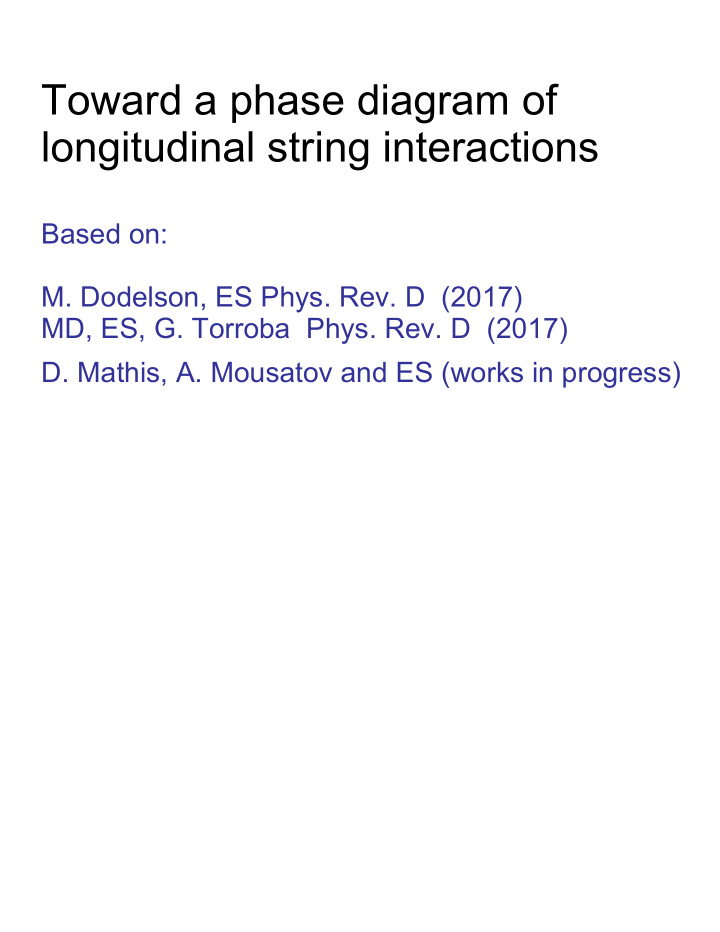



Toward a phase diagram of longitudinal string interactions Based on: M. Dodelson, ES Phys. Rev. D (2017) MD, ES, G. Torroba Phys. Rev. D (2017) D. Mathis, A. Mousatov and ES (works in progress)
Basic question: over what range in the longitudinal direction (i.e. the direction of relative motion) do strings interact?
String Spreading Susskind '94 + Lowe Polchinski Thorlacius Uglum '95... (authors had different interpretations...)
Two quadratically divergent sums appear in light cone string theory calculations. In spreading, the transverse Virasoro generators imply On the other hand, in the mass shell formula we have a quadratically divergent sum which is subtracted (local counterterm tunes away the worldsheet c.c.): In the superstring, the two are cleanly separated: the quadratically divergent worldsheet cosmological constant cancels, but the central term in the X^+ modes (transverse Virasoro generators) does not cancel.
Light cone time resolution (refined prediction) Note that this effect is causal, just non-local (the string is spread out, so can potentially interact before its center reaches the detector). This n_max agrees precisely with BPST '06 2->2 calculation, and with Gross-Mende
One motivation: weakly curved geometries with a horizon: evolution of trajectories of (say) two probes sent in with modest energy leads to a large nonlocal invariant energy in the near horizon region. How nonlocal is string theory in the longitudinal direction of relative motion between a string and a second object (detector)? String theory introduces beyond-GR physics at the singularity for obvious reasons, what about the horizon? cf string production Bachas, McAllister/Mitra, Senatore et al, Polchinski, ES '14, Puhm, Rojas, Ugajin '16.
Black hole mining: Mine itself detects early infaller given spreading
Kerr black hole high energy interactions (Banados, Silk, West '09) Large c.o.m. energy for very near- extremal case, for very near-horizon interactions. With string spreading, can de-tune the local collision. Also AdS/CFT `glueball' scattering etc.
So it is worth understanding whether the physical (light cone gauge) prediction is correct. Plan for the rest: *Tree-level test *Generalization to closed string (growing effect in time in BH) *Quantum effects *Building blocks for Eikonal amplitude *Scrambling timescale
A similar setup to the black hole appears at six points in flat space string scattering Test of longitudinal interaction.
Open string orderings AACCBB, AABBCC
We include wavepackets that strongly constrain the momenta in the longitudinal direction, while providing enough spatial resolution to test ~ E ' spread. We focus on a small momentum range in which the amplitude exhibits a certain structure, finding a significant test of the effect there. Tree-level QFT provides a control group, operationally: analyze with same wavepackets and check if the resulting amplitude A(X) is parametrically suppressed compared to the string theory case. Lightlike linear dilaton traces the location of interaction, consistent with scattering at spreading radius (rather than wavepacket tail).
QFT comparison model(s)
Basic result (delicate choice of ): A(X) in ST exhibits properties: *Beats QFT at X ~-E ' *A(X) support peaked there *string coupling g s (X) consistent with interaction at spreading radius. *Amplitude not convergent sum of QFT propagators (not sum of QFT1 models)
Within support of the wavepacket, the amplitude takes the form Beta funtion does not admit a convergent expansion of propagators 1/(k D^2 +n)
Could the ST answer be on tail of wavefunction? A priori, might take advantage of higher momentum- space amplitude elsewhere in p c . But Gaussian wavepacket suppresses this, and dilaton tracer consistent with spreading interaction.
How does this compare to light cone prediction? Consistent: Also incorporating the dilaton g~exp(VX) into the light cone prediction reveals that it degrades for X~1/V. This behavior comes out of the S-matrix amplitude as well, along with expected power of g(Xspreading).
Closed string version: similar spreading regime, but overall s- dependence stronger: => growth => need quantum corrections
Finite string coupling: light cone calculation invoked high-energy modes (shut off at finite g); Gross-Mende find scale of non-locality suppressed like 1/genus; if scatterers (bit of string + detector) hit their own r_Schwarzshild then breaks down. Next step: Eikonal scattering GR version:
Building block (includes permutations): Eikonal obtained by joining C's, integrating over momenta.
This contains a symmetric contribution which is a product of the tree-level results, each with - j N.
Veneziano et al have been developing a phase diagram for high energy scattering. A longer-term goal is to generalize the whole diagram to incorporate longitudinal effect (probed at higher points as described here, or in a BH background with the large non-local s). With that in hand, we could obtain an accurate estimate for string theory interactions near black holes. (So far, other approaches to BH info more dramatic (e.g. traversable wormholes carrying out the info?))
Summary: Longitudinally separated interactions pass strong S-matrix test, at scale ~ E '. This raises interesting questions and suggests several applications, including interactions between separated horizon infallers. Closed string version grows with time, loop corrections controllable until ~scrambling time (full effect still TBD).
Recommend
More recommend